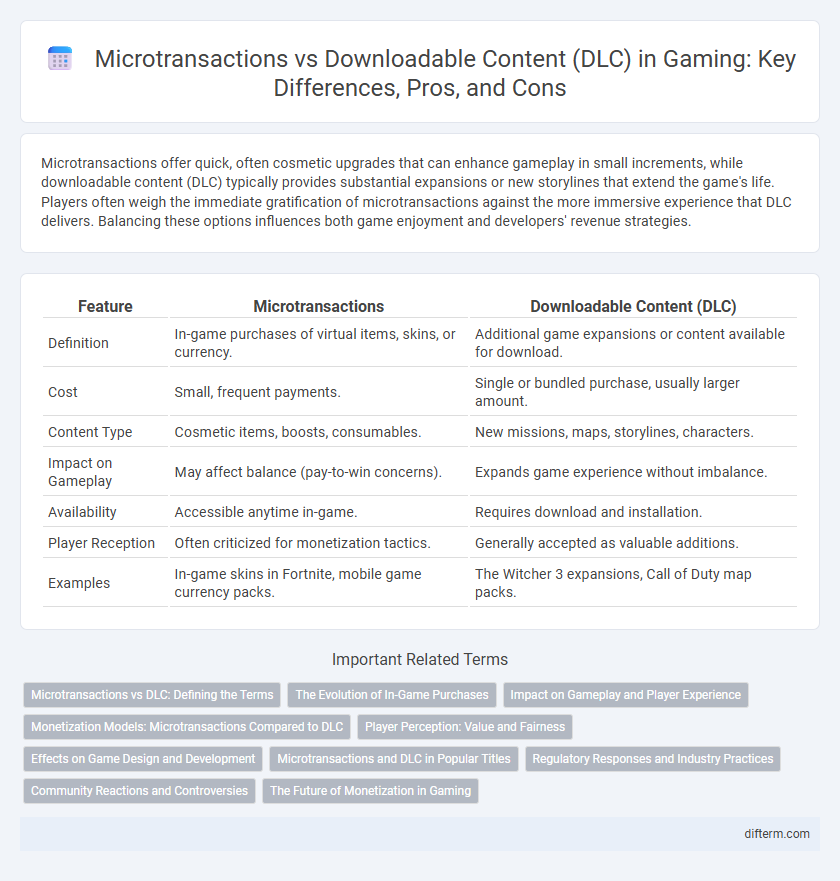Microtransactions offer quick, often cosmetic upgrades that can enhance gameplay in small increments, while downloadable content (DLC) typically provides substantial expansions or new storylines that extend the game's life. Players often weigh the immediate gratification of microtransactions against the more immersive experience that DLC delivers. Balancing these options influences both game enjoyment and developers' revenue strategies.
Table of Comparison
| Feature | Microtransactions | Downloadable Content (DLC) |
|---|---|---|
| Definition | In-game purchases of virtual items, skins, or currency. | Additional game expansions or content available for download. |
| Cost | Small, frequent payments. | Single or bundled purchase, usually larger amount. |
| Content Type | Cosmetic items, boosts, consumables. | New missions, maps, storylines, characters. |
| Impact on Gameplay | May affect balance (pay-to-win concerns). | Expands game experience without imbalance. |
| Availability | Accessible anytime in-game. | Requires download and installation. |
| Player Reception | Often criticized for monetization tactics. | Generally accepted as valuable additions. |
| Examples | In-game skins in Fortnite, mobile game currency packs. | The Witcher 3 expansions, Call of Duty map packs. |
Microtransactions vs DLC: Defining the Terms
Microtransactions refer to small in-game purchases that allow players to acquire virtual goods, currency, or enhancements individually, often in free-to-play or live-service games. Downloadable content (DLC) represents larger expansions or add-ons to the base game, providing new storylines, levels, or features through a one-time purchase. Understanding the distinction between microtransactions as incremental, optional purchases and DLC as substantial content expansions is crucial for evaluating game monetization strategies.
The Evolution of In-Game Purchases
Microtransactions have evolved from simple cosmetic items to complex systems involving loot boxes, battle passes, and in-game currencies, driving continuous revenue streams for developers. Downloadable content (DLC) initially offered substantial expansions and new storylines but now often complements microtransactions with smaller, incremental additions. The shift reflects changing player preferences and industry monetization strategies, emphasizing ongoing engagement over one-time purchases.
Impact on Gameplay and Player Experience
Microtransactions often fragment gameplay by encouraging repetitive small purchases that can disrupt immersion and create pay-to-win scenarios, whereas downloadable content (DLC) typically offers substantial additions that extend storylines and gameplay mechanics, enhancing player engagement. Microtransactions may lead to player frustration due to perceived unfair advantages or excessive monetization, while DLC is generally viewed as valuable content that enriches the overall experience without compromising game balance. The impact on player experience varies widely, with DLC fostering a deeper narrative connection and microtransactions risking gameplay imbalance and player dissatisfaction.
Monetization Models: Microtransactions Compared to DLC
Microtransactions offer ongoing revenue streams by enabling players to purchase virtual goods or enhancements incrementally, often appealing to free-to-play game models. Downloadable Content (DLC) involves larger, one-time purchases that expand the base game with new stories, levels, or features, attracting players interested in significant content additions. The choice between microtransactions and DLC impacts player engagement, monetization strategy, and game design, with microtransactions supporting continuous spending and DLC fostering deeper narrative experiences.
Player Perception: Value and Fairness
Players often perceive downloadable content (DLC) as offering greater value and fairness due to its substantial, content-rich expansions compared to microtransactions, which are frequently seen as small, repetitive purchases that can hinder gameplay balance. DLC usually enhances the gaming experience with new storylines, maps, or characters, providing clear, tangible benefits, whereas microtransactions are sometimes criticized for promoting pay-to-win scenarios or fragmenting the player base. This distinction influences player satisfaction and willingness to invest, making DLC more favored among gamers seeking meaningful content expansions over incremental transactions.
Effects on Game Design and Development
Microtransactions often lead to game design centered around repetitive actions and incentivized spending, altering core gameplay balance to maximize revenue. Downloadable content (DLC) typically expands the original narrative or game world, allowing developers to extend playtime without disrupting the primary experience. Both models influence development priorities, with microtransactions encouraging ongoing content updates and DLC promoting episodic or substantial post-launch releases.
Microtransactions and DLC in Popular Titles
Microtransactions dominate popular titles like Fortnite and Call of Duty, offering players cosmetic items and gameplay boosts through small in-game purchases. Downloadable content (DLC) in games such as The Witcher 3 and Skyrim provides substantial story expansions and new gameplay mechanics, enhancing long-term player engagement. The balance between microtransactions and DLC influences player retention and revenue models across the gaming industry.
Regulatory Responses and Industry Practices
Regulatory responses to microtransactions often address concerns over gambling-like mechanics and consumer protection, resulting in stricter age ratings and transparency requirements in regions like the EU and South Korea. Industry practices vary, with some developers prioritizing substantial downloadable content (DLC) that expands gameplay meaningfully, while others rely heavily on microtransactions to generate ongoing revenue through cosmetic or convenience items. Regulatory scrutiny is encouraging a shift toward balancing monetization with player experience, prompting studios to design ethical and transparent in-game economies.
Community Reactions and Controversies
Microtransactions in gaming often spark community backlash due to perceived pay-to-win mechanics and excessive monetization, undermining player experience. Downloadable content (DLC), while sometimes criticized for fragmenting the game or charging for content previously omitted, generally receives more acceptance when it adds substantial value. Controversies intensify when microtransactions involve loot boxes or gambling elements, prompting widespread calls for regulatory scrutiny.
The Future of Monetization in Gaming
Microtransactions continue to dominate the gaming industry by offering players incremental purchases such as cosmetic items, in-game currency, and battle passes, fueling ongoing revenue streams. Downloadable content (DLC) provides substantial expansions and story-driven add-ons that enhance player engagement and extend game longevity. The future of monetization in gaming leans toward hybrid models combining microtransactions' flexibility with DLC's immersive content, supported by evolving technologies like cloud gaming and blockchain for secure, personalized experiences.
microtransactions vs downloadable content (DLC) Infographic

 difterm.com
difterm.com